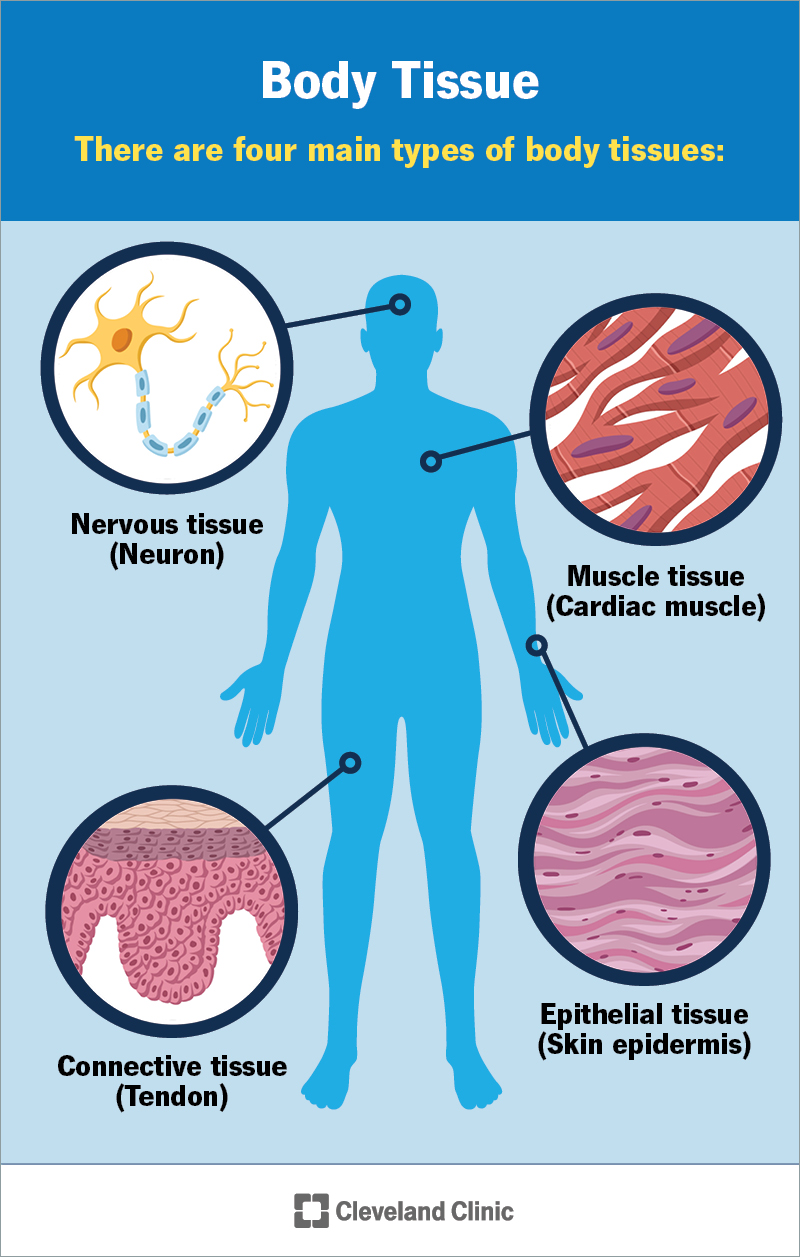One step up from cells are tissues. These collections of cells handle specific jobs throughout your body. There are four main types of tissues: epithelial, connective, muscle and nervous. But people commonly use the term “tissue” informally to talk about parts and structures throughout the body, too.
Advertisement
Cleveland Clinic is a non-profit academic medical center. Advertising on our site helps support our mission. We do not endorse non-Cleveland Clinic products or services. Policy
Body tissues are groups of cells that all have similar or related jobs. They work together as part of larger structures, like organs, to run your body.
Advertisement
Cleveland Clinic is a non-profit academic medical center. Advertising on our site helps support our mission. We do not endorse non-Cleveland Clinic products or services. Policy
Your body has levels of organization. One way to think about it is like the levels of a major corporation. The top-to-bottom breakdown works like so:

There are four main types of body tissues:
It’s common for people to often refer to other types of tissues, like soft, vascular or brain tissue. But these aren’t specific, formally recognized types.
For example, bone tissue is technically connective tissue. And it includes both harder, mineralized bone tissue and the soft, spongy bone marrow inside.
Similarly, brain tissue is a blanket term that applies to different things. It applies to gray matter, which is how neurons cluster together so their cell bodies bunch up like florets on a head of broccoli. But every neuron has an arm-like extension, the axon, that branches off. Those axons form white matter nervous tissue, which also bunches together like the stems and branches on a head of broccoli. And nervous tissue also includes things like glial cells, which are there to support the neurons.
Advertisement
Body tissues have different jobs, depending on the type.
Epithelial tissue is there to form boundary layers or separations. For example, the epidermis of your skin and epithelium of your cornea protect tissues inside your body from the outside world. Epithelial tissues can also act like gatekeepers, controlling what can pass through.
This type of tissue comes in one or more layers, with little or no space between cells. The cells have a neat, orderly arrangement that’s important to how these tissues work.
Some connective tissues literally hold your body together. Others simply link different body parts and systems so they can work cooperatively.
Connective tissue cells have much more space between them compared to epithelial cells. Filling the space between the cells is a substance called a matrix. The proteins and other matrix components are what determine the tissue’s density, hardness, etc.
Muscle tissue is all about movement. It consists of fibers that intertwine and bundle together. The bundles flex and twist together, making bundles much stronger than an individual muscle fiber.
Some of that movement is internal. One example is how your heart muscle flexes to pump blood. Another is how muscles in your digestive tract push food through during digestion. It also includes how skeletal muscles let you move part or all of your body around.
Muscle tissue is also distinct from most other tissue types because it’s electrically reactive. That means muscles tense or flex in reaction to electrical signals. That reactivity is a key part of how every muscle in your body works.
Nervous tissue also consists of fibers, but they don’t flex or move. Instead, they form connections that send and relay electrical and chemical signals at enormous speeds.
This tissue is all about sending and relaying signals. It lets different parts of your body communicate with each other. Similar to muscle tissue, nervous tissue is also electrically reactive. It relies on chemical signals, too.
The main difference is that most nervous tissue reacts by resending the signal, relaying it until it reaches its destination. But some areas of nervous tissue work the opposite way. Instead of relaying signals, they react like circuit breakers to stop signals.
Connective tissue is the most abundant, mainly because it applies to so many tissue types. It includes things like skin (except for the outermost layer, which is epithelial tissue) and bones. But it also includes fluids like blood and lymph, and many other types of tissue. Connective tissue is also the most widespread. It goes just about everywhere in your body.
Advertisement
Whether you think about the word or not, tissue is literally the stuff you’re made of. But what if your healthcare provider tells you that they want to take a tissue sample? Or maybe they tell you that you have a disease that only affects a certain type of tissue? That might be all it takes for that word to go from commonplace to overwhelming.
If you have questions about what your healthcare provider means when they talk about tissues, don’t hesitate to ask. Part of their job is to help you understand and feel well-informed about what’s happening with your health.
Advertisement
Cleveland Clinic’s primary care providers offer lifelong medical care. From sinus infections and high blood pressure to preventive screening, we’re here for you.

Last reviewed on 04/01/2025.
Learn more about the Health Library and our editorial process.